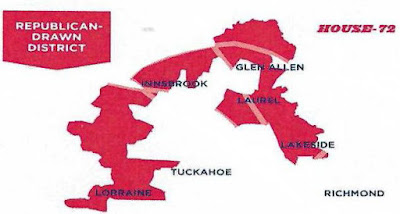Public can have a say in Virginia redistricting effort
 |
| The Redistricting Commission could redraw gerrymandered districts like this one. |
Members of the public are invited to provide input into
Virginia’s redistricting process at a hearing July 27 at George Mason
University in Fairfax.
The hearing, at 4 p.m. in Dewberry Hall in GMU’s Johnson Center, will help guide the Virginia Redistricting Commission’s work to redraw the maps for the Virginia Senate and House of
Delegates and U.S. congressional districts. People can testify in person or
virtually. Registration information will be available here.
Virginia voters approved a constitutional amendment in
November 2020 to create a bipartisan Redistricting Commission. The General Assembly subsequently passed legislation to formalize and refine the process.
Communities of interest
The commission has 16 members, including eight legislators and seven citizens. This is the first time citizens are included in the
process, says Mason District resident Bill Millhouser, of OneVirginia2021, a grassroots organization dedicated to ending partisan gerrymandering.
There are two legislative representatives on the commission
from Northern Virginia: Sen. George Barker (Alexandria) and Del. Marcus Simon
(Falls Church).
District boundaries for state elected officials and members of Congress are reviewed every 10 years following the latest Census data. Districts have to be equitable in terms of population within a few percentage points.
After the 2020 Census results come out in mid-August, the commission will have 45 days to draw legislative maps, get feedback from the public, and submit the maps to the General Assembly for approval.
The new maps should take into account population shifts, protect minority voters, and keep “communities of interest” intact, as well as reduce gerrymandering.
 |
| A gerrymandered House district surrounds the city of Richmond. |
A community of interest
refers to a neighborhood or a geographically defined group of people who share
similar social, cultural, and economic interests. As an example, the commission might want to consider central
Annandale a community of interest that should not be broken up among
districts.
People can use a mapping tool on the OneVirginia2021Foundation website to create a visual representation of a community of interest.
Eliminating gerrymandering
District 37 is a long, thin, curvy shape that stretches from the east side of
Lake Barcroft to Centreville, running through parts of Annandale, Burke, and
Springfield. That district was developed by Democrats to ensure the party keeps
that seat.
The residents of that district have very different issues,
Millhouser notes. A more compact district might be more likely to serve people
with common interests.
An example of a Republican-created district is Virginia
House of Delegates District 72, which forms a semi-circle through the suburbs
around Richmond.
Another factor is the need to avoid splitting up voting precincts. Candace Butler, of OneVirginia2021, notes that her precinct, St. Albans in Mason District, used to be entirely in the 11th congressional district (Rep. Gerry Connolly), but after 2011 was split among the 11th and 8th (Rep. Don Beyer) districts.
Split precincts were set up to advantage one party over
another, Butler says. Having a bipartisan redistricting commission is “fundamentally
about minimizing party control of the process.”
Citizen involvement
A cornerstone requirement of the redistricting effort is the
need to comply with the federal Voting Rights Act, which prohibits the “packing”
of districts to serve a particular racial or ethnic group, Millhouser says.
That all but ensures a district will have a minority representative but limits
racial and ethnic minorities’ representation in other districts.
It’s a complicated balancing act, he says; you have to have
just enough minorities in a district, so voters of a racial or ethnic group
have a chance to elect someone from their group.
A key question for the commission – and the public – is, “Do
the districts really serve the public or do they serve the politicians?” Millhouser
says.
An ideal result of redistricting, according to Millhouser is
that “more people will see there is competition in races, so more people will
vote. Also more people will see there is a path to political office, to
actually stand for election.”
“We voted for citizen involvement in creating our legislative districts,” Millhouser and Butler say. “Now it’s time to use our voices in the once-a-decade redistricting process. If we don’t speak up, the commission members cannot know what matters to us when they draw the lines. Without our input, the temptation will be to follow old habits and draw the districts around the incumbents.”

I will be very surprised if all of St. Alban's Precinct and the rest of inner beltway Annandale don't end up in the 8th. Since we're already surrounded on three sides by the 8th, I doubt if community interest will be an obstacle. – Sparky